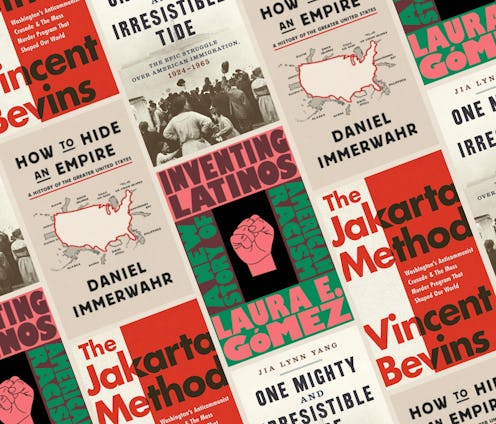Books
10 History Books Every American Needs To Read
These eye-opening books trace how the U.S. got to where it is today.

Americans are notoriously under-educated about their own history — and it’s been well-documented. Headlines in this vein have been popping up for years: Americans Know Little About Civic Affairs; Americans Know Literally Nothing About the Constitution; Flunking Civics: Why America's Kids Know So Little. It’s a phenomenon that’s… well, a tad embarrassing, to say the least. Much of this stems from structural forces, not least how little instruction U.S. public schools offer in the field of civics.
But it doesn’t have to be this way. Academics, historians, and critics continue to turn out revelatory books on American history, reshaping the country’s understanding of its own past by uncovering new details, or tracing throughlines hidden in plane sight. So if you’re looking to brush up on your U.S. history — or are already an expert, hoping to dive even deeper — there are plenty of non-fiction reads to crack open.
Before the country can move forward, it’s necessary to first understand how America got to where it is today — the good, the bad, the brilliant, the unjust, and the downright ugly. Get started with the 10 American history books listed below.
We only include products that have been independently selected by Bustle's editorial team. However, we may receive a portion of sales if you purchase a product through a link in this article.
1
The Jakarta Method: Washington's Anticommunist Crusade And The Mass Murder Program That Shaped Our World
From Vincent Bevins, the Southeast Asian correspondent for The Washington Post, comes this eye-opening look at how the United States violently suppressed leftist movements in Asia and Latin America. Drawing from the events of the Indonesian genocide in 1965, The Jakarta Method examines how the U.S. has worked behind the scenes to usher in regime changes across the globe.
2
Inventing Latinos: A New Story of American Racism by Laura E. Gómez
UCLA Law Professor Laura E. Gómez examines the complex history of international relations between the U.S. and Latin America. Much like Nell Irvin Painter’s The History of White People, Inventing Latinos is concerned with how people decide who belongs to which race — and how those decisions shape the future.
3
The Heartland: An American History by Kristin L. Hoganson
Born, raised, and educated on the East Coast, Kristin L. Hoganson expected a culture shock when she landed in Champaign, Illinois, deep inside the so-called heartland of the United States. When the Midwest turned out to be much different than she expected, Hoganson began to research the area’s history and culture — a passion project that resulted in this much-lauded 2019 book.
4
How to Hide an Empire: A History of the Greater United States by Daniel Immerwahr
Examining the history and endurance of U.S. colonialism, Daniel Immerwahr’s How to Hide an Empire offers a fascinating look at which countries the U.S. military occupies and why. From pineapples to guano to medical experimentation, Immerwahr traces the expansion of the United States beyond its contiguous borders, and analyzes how that expansion has affected the globe.
5
Four Hundred Souls: A Community History of African America, 1619-2019
Comprised of 90 essays, short stories, poems, and snippets of memoir, each of which covers five of the 400 years between 1619 — when the White Lion, a ship carrying 20 enslaved Africans, landed in colonial Virginia — and 2019, Four Hundred Souls is unlike any other history book you’ll read.
6
The Three-Cornered War: The Union, the Confederacy, and Native Peoples in the Fight for the West
Civil War stories and tales of the Wild West don’t typically mix in American pop culture — and when they do, they usually center on Civil War veterans living far from East Coast conflicts. As Megan Kate Nelson reveals in The Three-Cornered War, however, battles to control the United States’ “Wild” side were fought concurrently with the Union-Confederacy conflict, and the two conflicts helped shape public opinion on both fronts.
7
Unworthy Republic: The Dispossession of Native Americans and the Road to Indian Territory
In this National Book Award finalist, Claudio Saint reveals how Andrew Jackson’s Indian Removal Act of 1830, which sought to forcibly relocate 80,000 Native Americans westward across the Mississippi, resulted in catastrophic losses of life and fortune for Indigenous people in the United States — forever changing the American social and political landscape.
8
Race for Profit: How Banks and the Real Estate Industry Undermined Black Homeownership
A Pulitzer Prize finalist, Keeanga-Yamahtta Taylor’s Race for Profit exposes the ongoing legacy of redlining — and how the real estate industry is partially responsible for it. Decades before the housing bubble collapsed, big banks exploited Black homeowners’ financial struggles, dealing in unfair lending practices that burdened new buyers with debts they could not hope to repay.
9
Caste: The Origins of Our Discontents
Focusing on the hidden caste system in the United States, this book from The Warmth of Other Suns author and Pulitzer Prize-winner Isabel Wilkerson is an all-too-timely read today, when billionaires take joyrides to outer space while the oceans burn. Caste exposes how something far more complex and nebulous than race or class alone structures American society.
10
One Mighty and Irresistible Tide: The Epic Struggle over American Immigration, 1924-1965
In 1924, Congress enacted sweeping legislative changes that prevented immigration from much of Europe and Asia. Under the new laws, America restricted non-western immigration to one-fifth of its pre-WWI allowances, and drastically limited the number of people who could immigrate from each country every year, using calculations based on immigrant populations recorded in the 1890 U.S. census. When those practices were finally lifted, via another act of Congress, in 1965, the United States would never be the same.
This article was originally published on